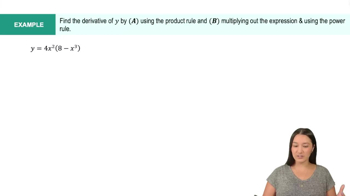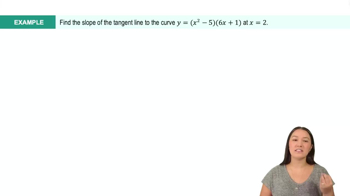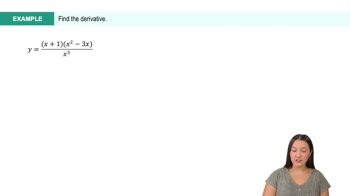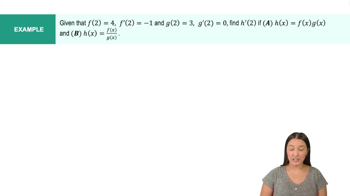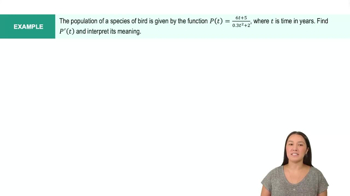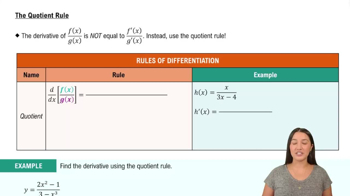Table of contents
- 0. Functions7h 52m
- Introduction to Functions16m
- Piecewise Functions10m
- Properties of Functions9m
- Common Functions1h 8m
- Transformations5m
- Combining Functions27m
- Exponent rules32m
- Exponential Functions28m
- Logarithmic Functions24m
- Properties of Logarithms34m
- Exponential & Logarithmic Equations35m
- Introduction to Trigonometric Functions38m
- Graphs of Trigonometric Functions44m
- Trigonometric Identities47m
- Inverse Trigonometric Functions48m
- 1. Limits and Continuity2h 2m
- 2. Intro to Derivatives1h 33m
- 3. Techniques of Differentiation3h 18m
- 4. Applications of Derivatives2h 38m
- 5. Graphical Applications of Derivatives6h 2m
- 6. Derivatives of Inverse, Exponential, & Logarithmic Functions2h 37m
- 7. Antiderivatives & Indefinite Integrals1h 26m
- 8. Definite Integrals4h 44m
- 9. Graphical Applications of Integrals2h 27m
- 10. Physics Applications of Integrals 2h 22m
3. Techniques of Differentiation
Product and Quotient Rules
Problem 3.4.99b
Textbook Question
Product Rule for three functions Assume f, g, and h are differentiable at x.
b. Use the formula in (a) to find d/dx(e^x(x−1)(x+3))
 Verified step by step guidance
Verified step by step guidance1
Step 1: Identify the functions involved in the product. Here, we have three functions: $f(x) = e^x$, $g(x) = (x - 1)$, and $h(x) = (x + 3)$. We need to differentiate the product $f(x)g(x)h(x)$.
Step 2: Recall the product rule for three functions. If $u(x)$, $v(x)$, and $w(x)$ are differentiable functions, then the derivative of their product is given by: $\frac{d}{dx}[u(x)v(x)w(x)] = u'(x)v(x)w(x) + u(x)v'(x)w(x) + u(x)v(x)w'(x)$.
Step 3: Differentiate each function individually. Compute $f'(x)$, $g'(x)$, and $h'(x)$. For $f(x) = e^x$, $f'(x) = e^x$. For $g(x) = (x - 1)$, $g'(x) = 1$. For $h(x) = (x + 3)$, $h'(x) = 1$.
Step 4: Apply the product rule for three functions. Substitute $f(x)$, $g(x)$, $h(x)$, and their derivatives into the formula: $\frac{d}{dx}[e^x(x-1)(x+3)] = e^x \cdot (x-1)(x+3) + e^x \cdot 1 \cdot (x+3) + e^x \cdot (x-1) \cdot 1$.
Step 5: Simplify the expression. Combine like terms and simplify the expression obtained in Step 4 to get the final derivative.
 Verified video answer for a similar problem:
Verified video answer for a similar problem:This video solution was recommended by our tutors as helpful for the problem above
Video duration:
5mPlay a video:
Was this helpful?
Key Concepts
Here are the essential concepts you must grasp in order to answer the question correctly.
Product Rule
The Product Rule is a fundamental differentiation rule used to find the derivative of the product of two or more functions. For two functions f(x) and g(x), the rule states that the derivative of their product is given by f'(x)g(x) + f(x)g'(x). This concept extends to three functions, where the derivative of f(x)g(x)h(x) is f'(x)g(x)h(x) + f(x)g'(x)h(x) + f(x)g(x)h'(x).
Recommended video:
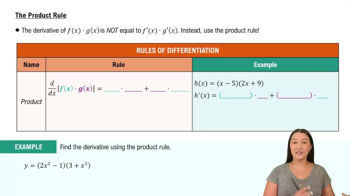
The Product Rule
Chain Rule
The Chain Rule is another essential differentiation technique that allows us to differentiate composite functions. If a function y is defined as a composition of two functions, such as y = f(g(x)), the Chain Rule states that the derivative is dy/dx = f'(g(x)) * g'(x). While not directly applied in the product rule, understanding the Chain Rule is crucial when dealing with functions that involve exponentials or other nested functions.
Recommended video:

Intro to the Chain Rule
Exponential Functions
Exponential functions, such as e^x, are functions where the variable appears in the exponent. The derivative of e^x is unique because it is equal to e^x itself, making it particularly straightforward to differentiate. In the context of the given problem, recognizing that e^x is part of the product allows for easier application of the Product Rule, as its derivative does not change the form of the function.
Recommended video:
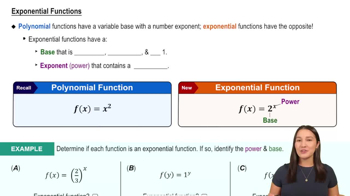
Exponential Functions
Related Videos
Related Practice



